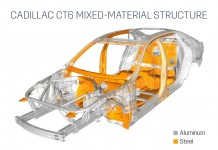General Motors filed for bankruptcy protection Monday, culminating the collapse of the automaker that once symbolized American global industrial might.
The filing in the same New York court that approved a speedy restructuring for Chrysler aims to allow GM to re-emerge as a new, leaner company within 60 to 90 days.
GM listed asset of 82.3 billion dollars and debts of 172.8 billion in the case, assigned to Judge Robert Gerber, in one of the biggest bankruptcy cases in US history.
The US industrial icon enters the process with billions in government financing and agreements already in place to cut labor costs, swap much of its debt for equity and reduce its liabilities by 50 percent.
Senior US officials pledged to provide 30 billion dollars to the “new GM” to emerge from the process, on top of nearly 20 billion dollars already loaned to the ailing firm.
The deal would give the US government a 60 percent stake in the auto giant, while the governments of Canada and Ontario, which have several GM factories, will provide an additional 9.5 billion dollars in financing and receive a 12 percent stake.
The European Opel and Vauxhall subsidiaries are leaving the GM empire under a rescue engineered this weekend in Germany with support from a Canadian company and a Russian bank.
Officials said the process is expected to be similar to that of Chrysler, which is expected to emerge from bankruptcy protection this week after just over a month.
However, the process will not be “as speedy as Chrysler because GM is a far larger, far more complicated global company,” senior administration officials cautioned.
President Barack Obama, who had given GM a deadline to come up with a viability plan, was to hold a press conference at 11:55 am (1555 GMT) Monday to discuss the state of the automotive industry.
Newly appointed GM chief executive officer Fritz Henderson, who is expected to continue to steer the new company, will speak to the media shortly afterwards.
The largest US automaker will close 11 plants and idle three others as it slashes its operating costs in order to lower its break-even point by 40 percent in terms of overall US industry sales.
Officials cautioned that the Obama administration has no intention of nationalizing General Motors over the long term and will not be participating in its day-to-day operations.
“The goal is to promote strong viable companies that can become profitable quickly and contribute to economic growth and jobs without government involvement,” a senior US official said.
Creditors holding about 54 percent of General’s Motors bonds agreed to a plan that would swap 27.1 billion dollars in debt for a 10 percent stake and warrants allowing them to buy an additional 15 percent stake, officials said.
Bondholders who rejected the plan could still fight it in court, but the government maintains they could end up with little or nothing if they take that path.
A retiree health care trust will receive a 17.5 percent stake in the new GM and 6.5 billion dollars in preferred stock in exchange for forgiving much of a 20-billion-dollar obligation.
Employees will continue to be paid and GM will immediately seek permission to continue to pay suppliers and honor customer warranties.
GM will also offer about 40 percent of its dealers 18 months to wind down their operations and will immediately seek permission to honor incentives offered to its remaining dealers, under a plan to shrink the number of GM sales outlets.
The GM filing came just hours after a US bankruptcy judge approved the sale of distressed US automaker Chrysler to a group led by Fiat, saying this was the only was to save the company and paving the way for its emergence from bankruptcy.
Judge Arthur Gonzalez wrote in his ruling that the deal was “the only option that is currently viable.”
The third-biggest US automaker filed for bankruptcy April 30 and is seeking a tie-up with Fiat in a plan presented as the only way to save the company from liquidation.
The government, which is also providing financing for the deal, says a new Chrysler company could be born within days of approval for the bankruptcy.
Fiat will initially get a 20 percent stake in Chrysler with an option to buy more.
In return, Fiat will allow access to its technology to enable the US carmaker to make the smaller, greener cars that are increasingly in demand.
The US Treasury has provided Chrysler with some nine billion dollars in emergency aid. Fiat must repay this money if it wants to take a majority stake in the Detroit firm.







